transmission FIAT 500X 2019 Owner handbook (in English)
[x] Cancel search | Manufacturer: FIAT, Model Year: 2019, Model line: 500X, Model: FIAT 500X 2019Pages: 284, PDF Size: 8.33 MB
Page 81 of 284
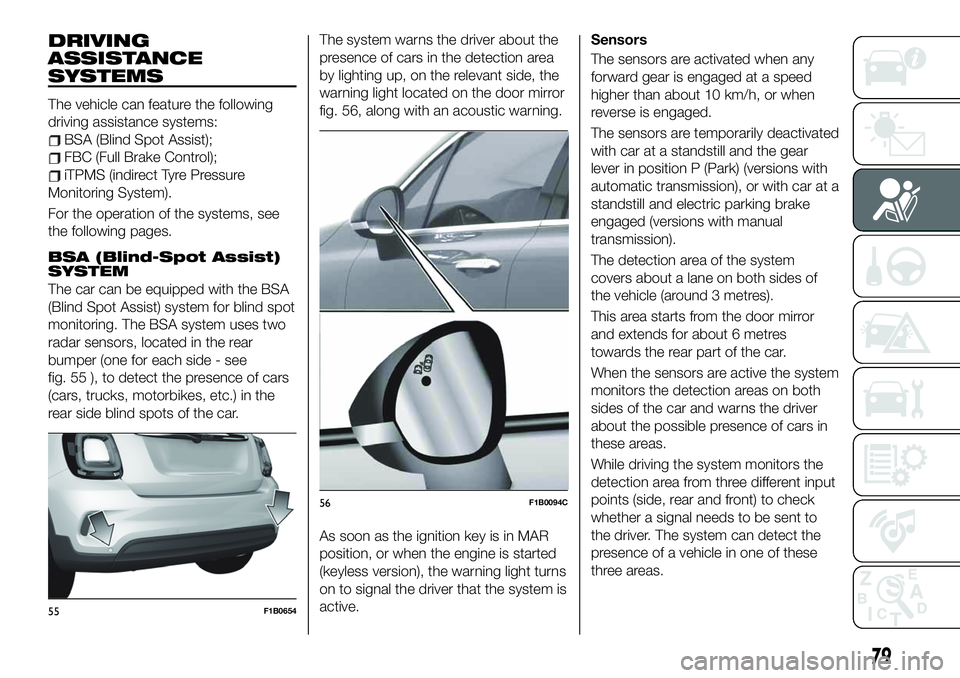
DRIVING
ASSISTANCE
SYSTEMS
The vehicle can feature the following
driving assistance systems:
BSA (Blind Spot Assist);
FBC (Full Brake Control);
iTPMS (indirect Tyre Pressure
Monitoring System).
For the operation of the systems, see
the following pages.
BSA (Blind-Spot Assist)
SYSTEM
The car can be equipped with the BSA
(Blind Spot Assist) system for blind spot
monitoring. The BSA system uses two
radar sensors, located in the rear
bumper (one for each side - see
fig. 55 ), to detect the presence of cars
(cars, trucks, motorbikes, etc.) in the
rear side blind spots of the car.The system warns the driver about the
presence of cars in the detection area
by lighting up, on the relevant side, the
warning light located on the door mirror
fig. 56, along with an acoustic warning.
As soon as the ignition key is in MAR
position, or when the engine is started
(keyless version), the warning light turns
on to signal the driver that the system is
active.Sensors
The sensors are activated when any
forward gear is engaged at a speed
higher than about 10 km/h, or when
reverse is engaged.
The sensors are temporarily deactivated
with car at a standstill and the gear
lever in position P (Park) (versions with
automatic transmission), or with car at a
standstill and electric parking brake
engaged (versions with manual
transmission).
The detection area of the system
covers about a lane on both sides of
the vehicle (around 3 metres).
This area starts from the door mirror
and extends for about 6 metres
towards the rear part of the car.
When the sensors are active the system
monitors the detection areas on both
sides of the car and warns the driver
about the possible presence of cars in
these areas.
While driving the system monitors the
detection area from three different input
points (side, rear and front) to check
whether a signal needs to be sent to
the driver. The system can detect the
presence of a vehicle in one of these
three areas.
55F1B0654
56F1B0094C
79
Page 84 of 284
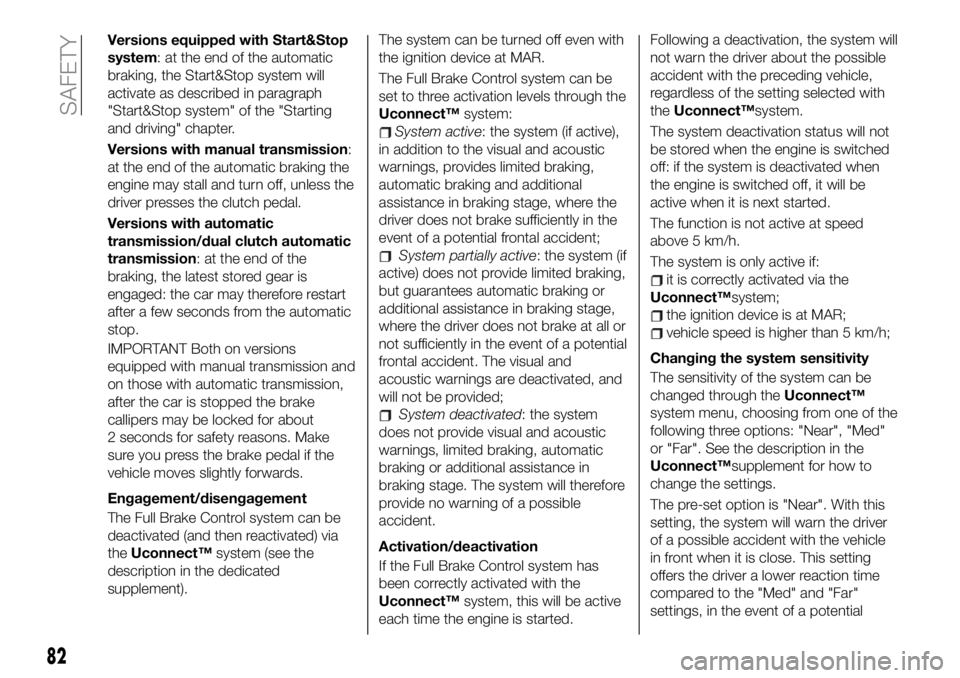
Versions equipped with Start&Stop
system: at the end of the automatic
braking, the Start&Stop system will
activate as described in paragraph
"Start&Stop system" of the "Starting
and driving" chapter.
Versions with manual transmission:
at the end of the automatic braking the
engine may stall and turn off, unless the
driver presses the clutch pedal.
Versions with automatic
transmission/dual clutch automatic
transmission: at the end of the
braking, the latest stored gear is
engaged: the car may therefore restart
after a few seconds from the automatic
stop.
IMPORTANT Both on versions
equipped with manual transmission and
on those with automatic transmission,
after the car is stopped the brake
callipers may be locked for about
2 seconds for safety reasons. Make
sure you press the brake pedal if the
vehicle moves slightly forwards.
Engagement/disengagement
The Full Brake Control system can be
deactivated (and then reactivated) via
theUconnect™system (see the
description in the dedicated
supplement).The system can be turned off even with
the ignition device at MAR.
The Full Brake Control system can be
set to three activation levels through the
Uconnect™system:
System active: the system (if active),
in addition to the visual and acoustic
warnings, provides limited braking,
automatic braking and additional
assistance in braking stage, where the
driver does not brake sufficiently in the
event of a potential frontal accident;
System partially active: the system (if
active) does not provide limited braking,
but guarantees automatic braking or
additional assistance in braking stage,
where the driver does not brake at all or
not sufficiently in the event of a potential
frontal accident. The visual and
acoustic warnings are deactivated, and
will not be provided;
System deactivated: the system
does not provide visual and acoustic
warnings, limited braking, automatic
braking or additional assistance in
braking stage. The system will therefore
provide no warning of a possible
accident.
Activation/deactivation
If the Full Brake Control system has
been correctly activated with the
Uconnect™system, this will be active
each time the engine is started.Following a deactivation, the system will
not warn the driver about the possible
accident with the preceding vehicle,
regardless of the setting selected with
theUconnect™system.
The system deactivation status will not
be stored when the engine is switched
off: if the system is deactivated when
the engine is switched off, it will be
active when it is next started.
The function is not active at speed
above 5 km/h.
The system is only active if:
it is correctly activated via the
Uconnect™system;
the ignition device is at MAR;
vehicle speed is higher than 5 km/h;
Changing the system sensitivity
The sensitivity of the system can be
changed through theUconnect™
system menu, choosing from one of the
following three options: "Near", "Med"
or "Far". See the description in the
Uconnect™supplement for how to
change the settings.
The pre-set option is "Near". With this
setting, the system will warn the driver
of a possible accident with the vehicle
in front when it is close. This setting
offers the driver a lower reaction time
compared to the "Med" and "Far"
settings, in the event of a potential
82
SAFETY
Page 115 of 284
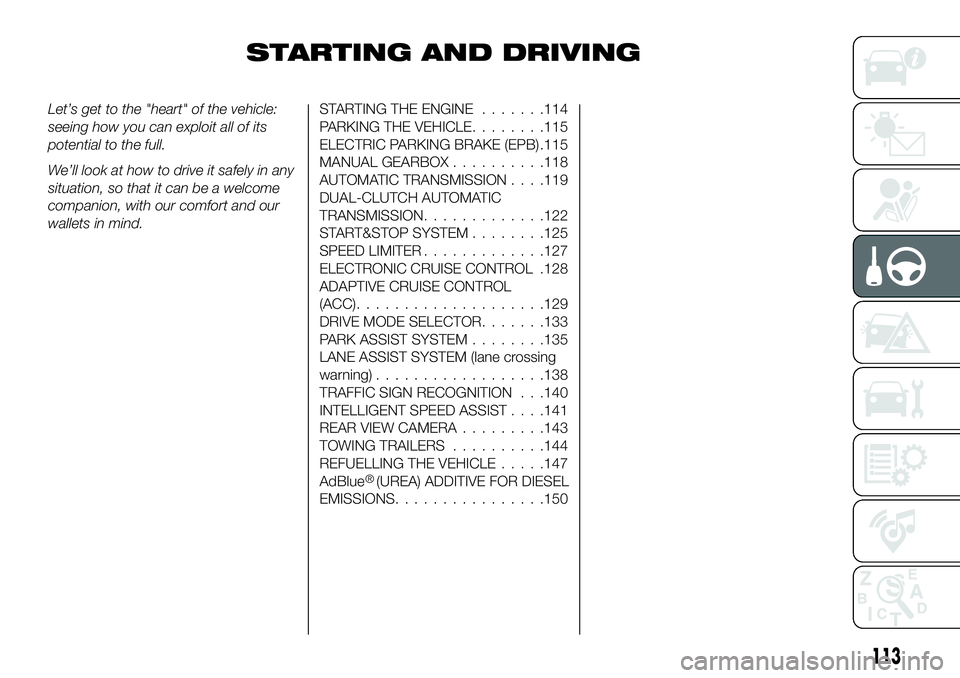
STARTING AND DRIVING
Let’s get to the "heart" of the vehicle:
seeing how you can exploit all of its
potential to the full.
We’ll look at how to drive it safely in any
situation, so that it can be a welcome
companion, with our comfort and our
wallets in mind.STARTING THE ENGINE.......114
PARKING THE VEHICLE........115
ELECTRIC PARKING BRAKE (EPB) .115
MANUAL GEARBOX..........118
AUTOMATIC TRANSMISSION. . . .119
DUAL-CLUTCH AUTOMATIC
TRANSMISSION.............122
START&STOP SYSTEM........125
SPEED LIMITER.............127
ELECTRONIC CRUISE CONTROL .128
ADAPTIVE CRUISE CONTROL
(ACC)....................129
DRIVE MODE SELECTOR.......133
PARK ASSIST SYSTEM........135
LANE ASSIST SYSTEM (lane crossing
warning)..................138
TRAFFIC SIGN RECOGNITION . . .140
INTELLIGENT SPEED ASSIST. . . .141
REAR VIEW CAMERA.........143
TOWING TRAILERS..........144
REFUELLING THE VEHICLE.....147
AdBlue (UREA) ADDITIVE FOR DIESEL
EMISSIONS................150
113
®
Page 116 of 284
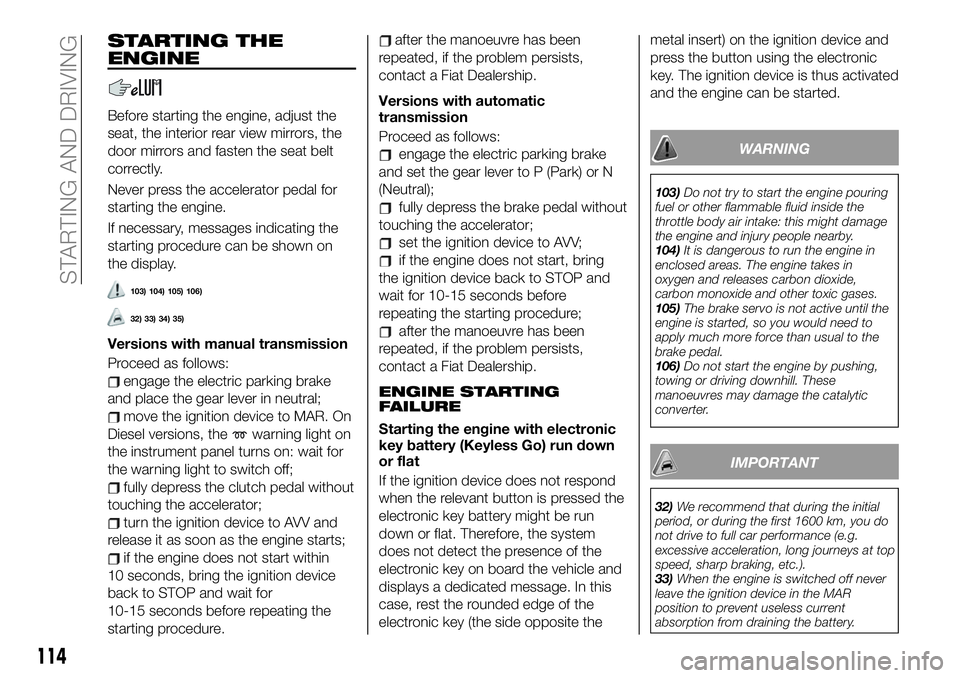
STARTING THE
ENGINE
Before starting the engine, adjust the
seat, the interior rear view mirrors, the
door mirrors and fasten the seat belt
correctly.
Never press the accelerator pedal for
starting the engine.
If necessary, messages indicating the
starting procedure can be shown on
the display.
103) 104) 105) 106)
32) 33) 34) 35)
Versions with manual transmission
Proceed as follows:
engage the electric parking brake
and place the gear lever in neutral;
move the ignition device to MAR. On
Diesel versions, the
warning light on
the instrument panel turns on: wait for
the warning light to switch off;
fully depress the clutch pedal without
touching the accelerator;
turn the ignition device to AVV and
release it as soon as the engine starts;
if the engine does not start within
10 seconds, bring the ignition device
back to STOP and wait for
10-15 seconds before repeating the
starting procedure.
after the manoeuvre has been
repeated, if the problem persists,
contact a Fiat Dealership.
Versions with automatic
transmission
Proceed as follows:
engage the electric parking brake
and set the gear lever to P (Park) or N
(Neutral);
fully depress the brake pedal without
touching the accelerator;
set the ignition device to AVV;
if the engine does not start, bring
the ignition device back to STOP and
wait for 10-15 seconds before
repeating the starting procedure;
after the manoeuvre has been
repeated, if the problem persists,
contact a Fiat Dealership.
ENGINE STARTING
FAILURE
Starting the engine with electronic
key battery (Keyless Go) run down
or flat
If the ignition device does not respond
when the relevant button is pressed the
electronic key battery might be run
down or flat. Therefore, the system
does not detect the presence of the
electronic key on board the vehicle and
displays a dedicated message. In this
case, rest the rounded edge of the
electronic key (the side opposite themetal insert) on the ignition device and
press the button using the electronic
key. The ignition device is thus activated
and the engine can be started.
WARNING
103)Do not try to start the engine pouring
fuel or other flammable fluid inside the
throttle body air intake: this might damage
the engine and injury people nearby.
104)It is dangerous to run the engine in
enclosed areas. The engine takes in
oxygen and releases carbon dioxide,
carbon monoxide and other toxic gases.
105)The brake servo is not active until the
engine is started, so you would need to
apply much more force than usual to the
brake pedal.
106)Do not start the engine by pushing,
towing or driving downhill. These
manoeuvres may damage the catalytic
converter.
IMPORTANT
32)We recommend that during the initial
period, or during the first 1600 km, you do
not drive to full car performance (e.g.
excessive acceleration, long journeys at top
speed, sharp braking, etc.).
33)When the engine is switched off never
leave the ignition device in the MAR
position to prevent useless current
absorption from draining the battery.
114
STARTING AND DRIVING
Page 117 of 284
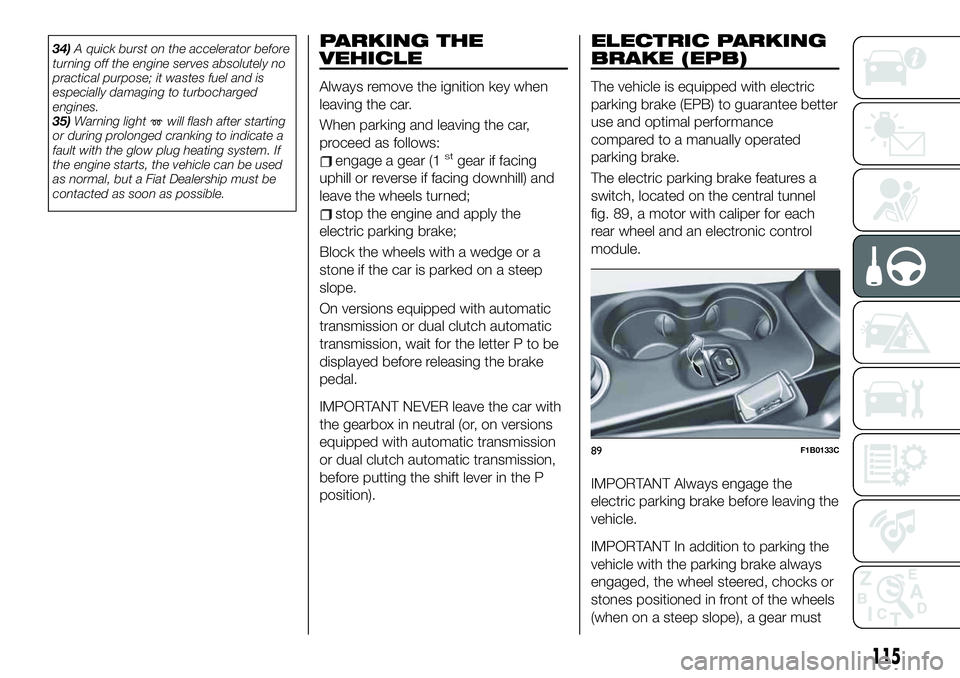
34)A quick burst on the accelerator before
turning off the engine serves absolutely no
practical purpose; it wastes fuel and is
especially damaging to turbocharged
engines.
35)Warning light
will flash after starting
or during prolonged cranking to indicate a
fault with the glow plug heating system. If
the engine starts, the vehicle can be used
as normal, but a Fiat Dealership must be
contacted as soon as possible.
PARKING THE
VEHICLE
Always remove the ignition key when
leaving the car.
When parking and leaving the car,
proceed as follows:
engage a gear (1stgear if facing
uphill or reverse if facing downhill) and
leave the wheels turned;
stop the engine and apply the
electric parking brake;
Block the wheels with a wedge or a
stone if the car is parked on a steep
slope.
On versions equipped with automatic
transmission or dual clutch automatic
transmission, wait for the letter P to be
displayed before releasing the brake
pedal.
IMPORTANT NEVER leave the car with
the gearbox in neutral (or, on versions
equipped with automatic transmission
or dual clutch automatic transmission,
before putting the shift lever in the P
position).
ELECTRIC PARKING
BRAKE (EPB)
The vehicle is equipped with electric
parking brake (EPB) to guarantee better
use and optimal performance
compared to a manually operated
parking brake.
The electric parking brake features a
switch, located on the central tunnel
fig. 89, a motor with caliper for each
rear wheel and an electronic control
module.
IMPORTANT Always engage the
electric parking brake before leaving the
vehicle.
IMPORTANT In addition to parking the
vehicle with the parking brake always
engaged, the wheel steered, chocks or
stones positioned in front of the wheels
(when on a steep slope), a gear must
89F1B0133C
115
Page 118 of 284
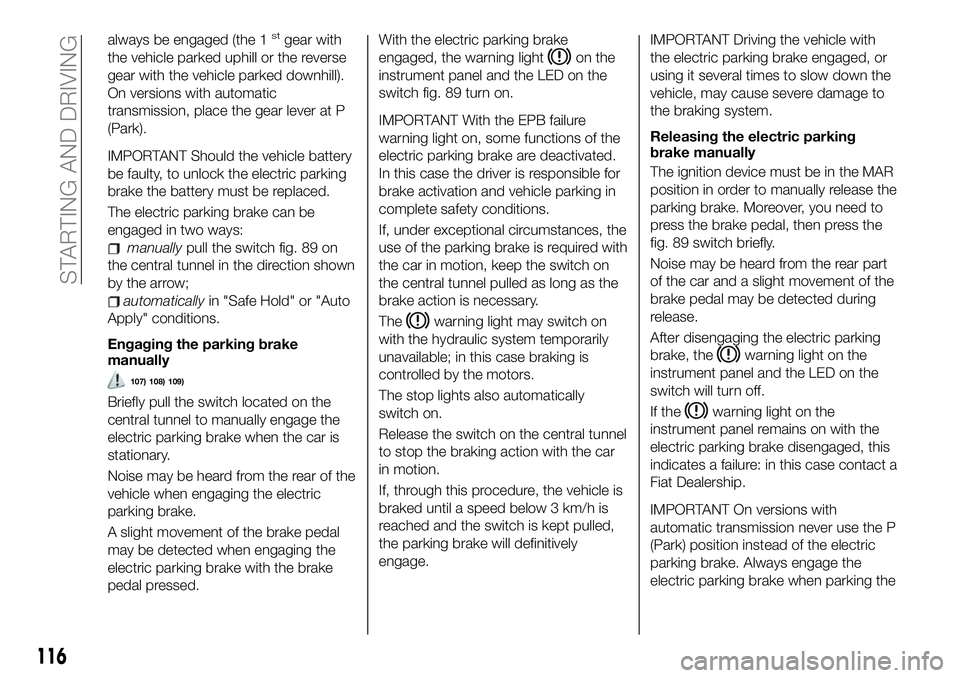
always be engaged (the 1stgear with
the vehicle parked uphill or the reverse
gear with the vehicle parked downhill).
On versions with automatic
transmission, place the gear lever at P
(Park).
IMPORTANT Should the vehicle battery
be faulty, to unlock the electric parking
brake the battery must be replaced.
The electric parking brake can be
engaged in two ways:
manuallypull the switch fig. 89 on
the central tunnel in the direction shown
by the arrow;
automaticallyin "Safe Hold" or "Auto
Apply" conditions.
Engaging the parking brake
manually
107) 108) 109)
Briefly pull the switch located on the
central tunnel to manually engage the
electric parking brake when the car is
stationary.
Noise may be heard from the rear of the
vehicle when engaging the electric
parking brake.
A slight movement of the brake pedal
may be detected when engaging the
electric parking brake with the brake
pedal pressed.With the electric parking brake
engaged, the warning light
on the
instrument panel and the LED on the
switch fig. 89 turn on.
IMPORTANT With the EPB failure
warning light on, some functions of the
electric parking brake are deactivated.
In this case the driver is responsible for
brake activation and vehicle parking in
complete safety conditions.
If, under exceptional circumstances, the
use of the parking brake is required with
the car in motion, keep the switch on
the central tunnel pulled as long as the
brake action is necessary.
The
warning light may switch on
with the hydraulic system temporarily
unavailable; in this case braking is
controlled by the motors.
The stop lights also automatically
switch on.
Release the switch on the central tunnel
to stop the braking action with the car
in motion.
If, through this procedure, the vehicle is
braked until a speed below 3 km/h is
reached and the switch is kept pulled,
the parking brake will definitively
engage.
IMPORTANT Driving the vehicle with
the electric parking brake engaged, or
using it several times to slow down the
vehicle, may cause severe damage to
the braking system.
Releasing the electric parking
brake manually
The ignition device must be in the MAR
position in order to manually release the
parking brake. Moreover, you need to
press the brake pedal, then press the
fig. 89 switch briefly.
Noise may be heard from the rear part
of the car and a slight movement of the
brake pedal may be detected during
release.
After disengaging the electric parking
brake, the
warning light on the
instrument panel and the LED on the
switch will turn off.
If the
warning light on the
instrument panel remains on with the
electric parking brake disengaged, this
indicates a failure: in this case contact a
Fiat Dealership.
IMPORTANT On versions with
automatic transmission never use the P
(Park) position instead of the electric
parking brake. Always engage the
electric parking brake when parking the
116
STARTING AND DRIVING
Page 119 of 284
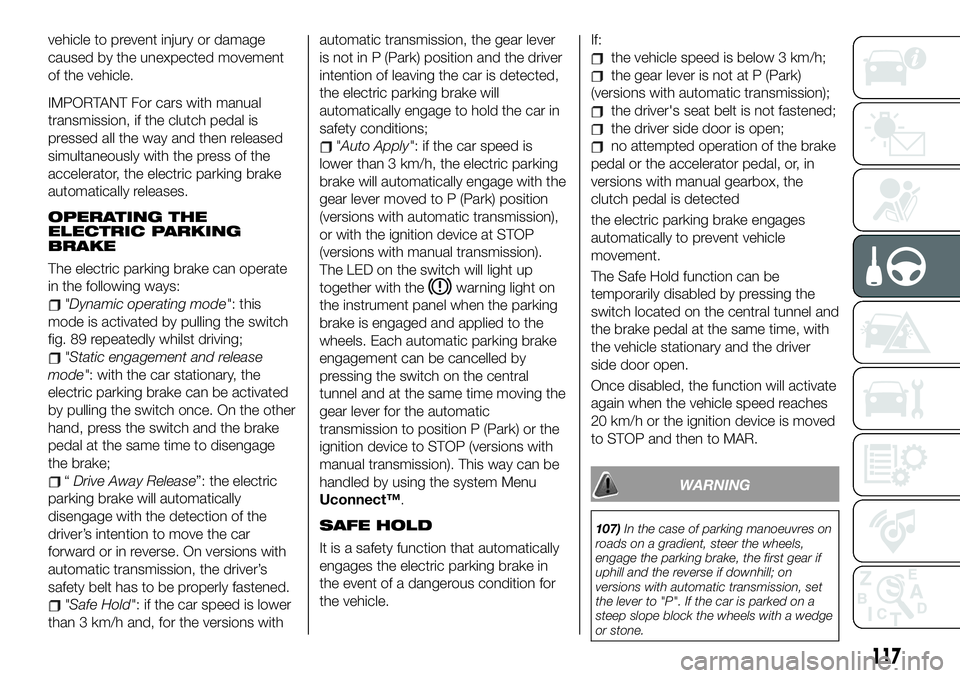
vehicle to prevent injury or damage
caused by the unexpected movement
of the vehicle.
IMPORTANT For cars with manual
transmission, if the clutch pedal is
pressed all the way and then released
simultaneously with the press of the
accelerator, the electric parking brake
automatically releases.
OPERATING THE
ELECTRIC PARKING
BRAKE
The electric parking brake can operate
in the following ways:
"Dynamic operating mode": this
mode is activated by pulling the switch
fig. 89 repeatedly whilst driving;
"Static engagement and release
mode": with the car stationary, the
electric parking brake can be activated
by pulling the switch once. On the other
hand, press the switch and the brake
pedal at the same time to disengage
the brake;
“Drive Away Release”: the electric
parking brake will automatically
disengage with the detection of the
driver’s intention to move the car
forward or in reverse. On versions with
automatic transmission, the driver’s
safety belt has to be properly fastened.
"Safe Hold": if the car speed is lower
than 3 km/h and, for the versions withautomatic transmission, the gear lever
is not in P (Park) position and the driver
intention of leaving the car is detected,
the electric parking brake will
automatically engage to hold the car in
safety conditions;
"Auto Apply": if the car speed is
lower than 3 km/h, the electric parking
brake will automatically engage with the
gear lever moved to P (Park) position
(versions with automatic transmission),
or with the ignition device at STOP
(versions with manual transmission).
The LED on the switch will light up
together with the
warning light on
the instrument panel when the parking
brake is engaged and applied to the
wheels. Each automatic parking brake
engagement can be cancelled by
pressing the switch on the central
tunnel and at the same time moving the
gear lever for the automatic
transmission to position P (Park) or the
ignition device to STOP (versions with
manual transmission). This way can be
handled by using the system Menu
Uconnect™.
SAFE HOLD
It is a safety function that automatically
engages the electric parking brake in
the event of a dangerous condition for
the vehicle.If:
the vehicle speed is below 3 km/h;
the gear lever is not at P (Park)
(versions with automatic transmission);
the driver's seat belt is not fastened;
the driver side door is open;
no attempted operation of the brake
pedal or the accelerator pedal, or, in
versions with manual gearbox, the
clutch pedal is detected
the electric parking brake engages
automatically to prevent vehicle
movement.
The Safe Hold function can be
temporarily disabled by pressing the
switch located on the central tunnel and
the brake pedal at the same time, with
the vehicle stationary and the driver
side door open.
Once disabled, the function will activate
again when the vehicle speed reaches
20 km/h or the ignition device is moved
to STOP and then to MAR.
WARNING
107)In the case of parking manoeuvres on
roads on a gradient, steer the wheels,
engage the parking brake, the first gear if
uphill and the reverse if downhill; on
versions with automatic transmission, set
the lever to "P". If the car is parked on a
steep slope block the wheels with a wedge
or stone.
117
Page 121 of 284
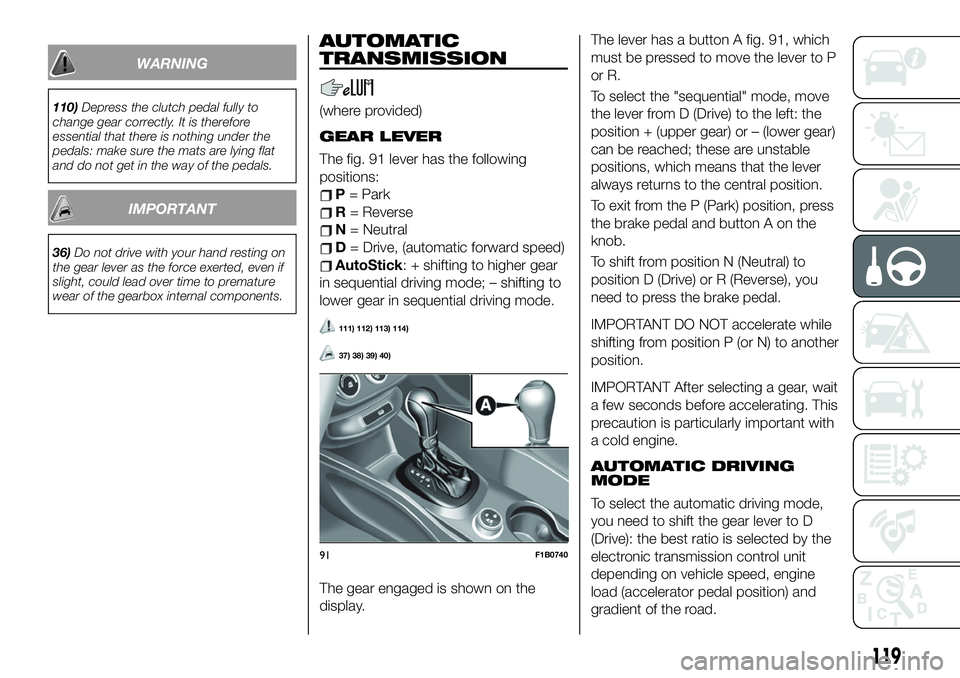
WARNING
110)Depress the clutch pedal fully to
change gear correctly. It is therefore
essential that there is nothing under the
pedals: make sure the mats are lying flat
and do not get in the way of the pedals.
IMPORTANT
36)Do not drive with your hand resting on
the gear lever as the force exerted, even if
slight, could lead over time to premature
wear of the gearbox internal components.
AUTOMATIC
TRANSMISSION
(where provided)
GEAR LEVER
The fig. 91 lever has the following
positions:
P= Park
R= Reverse
N= Neutral
D= Drive, (automatic forward speed)
AutoStick: + shifting to higher gear
in sequential driving mode; – shifting to
lower gear in sequential driving mode.
111) 112) 113) 114)
37) 38) 39) 40)
The gear engaged is shown on the
display.The lever has a button A fig. 91, which
must be pressed to move the lever to P
or R.
To select the "sequential" mode, move
the lever from D (Drive) to the left: the
position + (upper gear) or – (lower gear)
can be reached; these are unstable
positions, which means that the lever
always returns to the central position.
To exit from the P (Park) position, press
the brake pedal and button A on the
knob.
To shift from position N (Neutral) to
position D (Drive) or R (Reverse), you
need to press the brake pedal.
IMPORTANT DO NOT accelerate while
shifting from position P (or N) to another
position.
IMPORTANT After selecting a gear, wait
a few seconds before accelerating. This
precaution is particularly important with
a cold engine.
AUTOMATIC DRIVING
MODE
To select the automatic driving mode,
you need to shift the gear lever to D
(Drive): the best ratio is selected by the
electronic transmission control unit
depending on vehicle speed, engine
load (accelerator pedal position) and
gradient of the road.
91F1B0740
119
Page 122 of 284
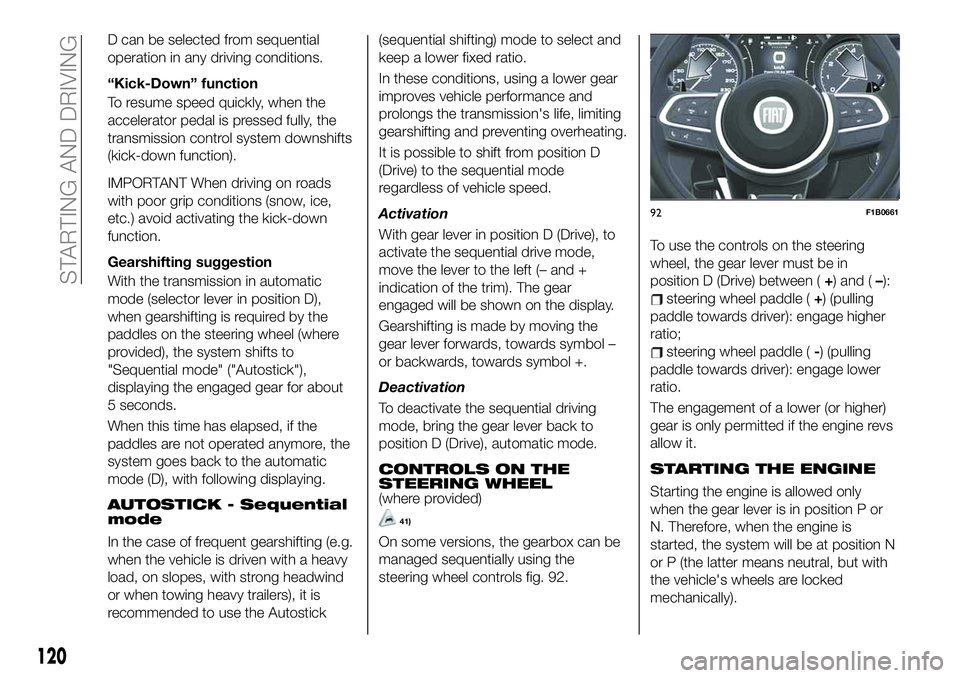
D can be selected from sequential
operation in any driving conditions.
“Kick-Down” function
To resume speed quickly, when the
accelerator pedal is pressed fully, the
transmission control system downshifts
(kick-down function).
IMPORTANT When driving on roads
with poor grip conditions (snow, ice,
etc.) avoid activating the kick-down
function.
Gearshifting suggestion
With the transmission in automatic
mode (selector lever in position D),
when gearshifting is required by the
paddles on the steering wheel (where
provided), the system shifts to
"Sequential mode" ("Autostick"),
displaying the engaged gear for about
5 seconds.
When this time has elapsed, if the
paddles are not operated anymore, the
system goes back to the automatic
mode (D), with following displaying.
AUTOSTICK - Sequential
mode
In the case of frequent gearshifting (e.g.
when the vehicle is driven with a heavy
load, on slopes, with strong headwind
or when towing heavy trailers), it is
recommended to use the Autostick(sequential shifting) mode to select and
keep a lower fixed ratio.
In these conditions, using a lower gear
improves vehicle performance and
prolongs the transmission's life, limiting
gearshifting and preventing overheating.
It is possible to shift from position D
(Drive) to the sequential mode
regardless of vehicle speed.
Activation
With gear lever in position D (Drive), to
activate the sequential drive mode,
move the lever to the left (– and +
indication of the trim). The gear
engaged will be shown on the display.
Gearshifting is made by moving the
gear lever forwards, towards symbol –
or backwards, towards symbol +.
Deactivation
To deactivate the sequential driving
mode, bring the gear lever back to
position D (Drive), automatic mode.
CONTROLS ON THE
STEERING WHEEL
(where provided)
41)
On some versions, the gearbox can be
managed sequentially using the
steering wheel controls fig. 92.To use the controls on the steering
wheel, the gear lever must be in
position D (Drive) between (+) and (–):
steering wheel paddle (+) (pulling
paddle towards driver): engage higher
ratio;
steering wheel paddle (-) (pulling
paddle towards driver): engage lower
ratio.
The engagement of a lower (or higher)
gear is only permitted if the engine revs
allow it.
STARTING THE ENGINE
Starting the engine is allowed only
when the gear lever is in position P or
N. Therefore, when the engine is
started, the system will be at position N
or P (the latter means neutral, but with
the vehicle's wheels are locked
mechanically).
92F1B0661
120
STARTING AND DRIVING
Page 123 of 284
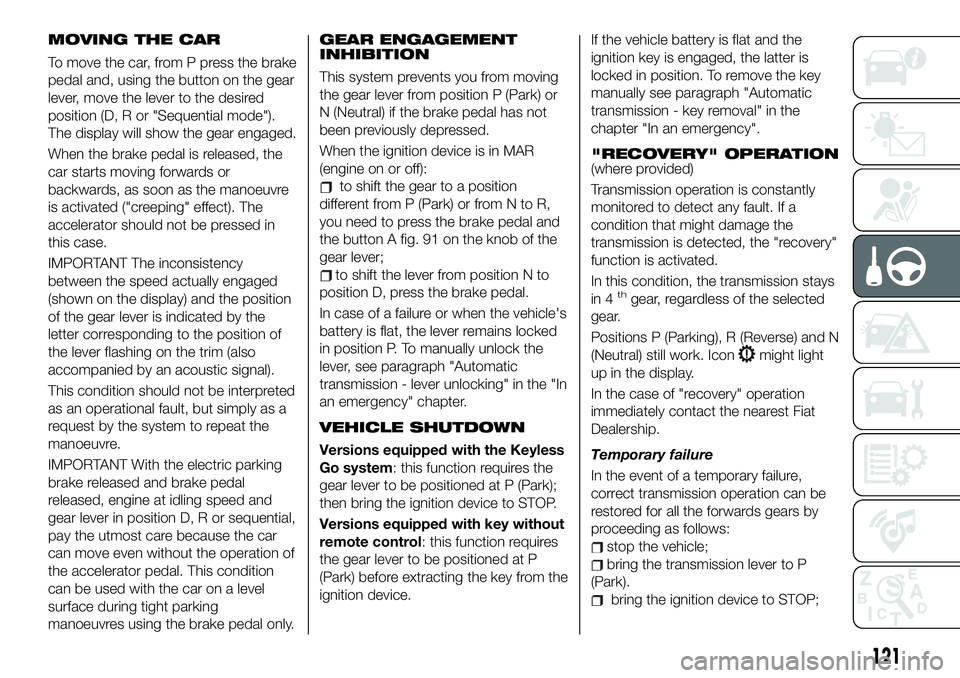
MOVING THE CAR
To move the car, from P press the brake
pedal and, using the button on the gear
lever, move the lever to the desired
position (D, R or "Sequential mode").
The display will show the gear engaged.
When the brake pedal is released, the
car starts moving forwards or
backwards, as soon as the manoeuvre
is activated ("creeping" effect). The
accelerator should not be pressed in
this case.
IMPORTANT The inconsistency
between the speed actually engaged
(shown on the display) and the position
of the gear lever is indicated by the
letter corresponding to the position of
the lever flashing on the trim (also
accompanied by an acoustic signal).
This condition should not be interpreted
as an operational fault, but simply as a
request by the system to repeat the
manoeuvre.
IMPORTANT With the electric parking
brake released and brake pedal
released, engine at idling speed and
gear lever in position D, R or sequential,
pay the utmost care because the car
can move even without the operation of
the accelerator pedal. This condition
can be used with the car on a level
surface during tight parking
manoeuvres using the brake pedal only.GEAR ENGAGEMENT
INHIBITION
This system prevents you from moving
the gear lever from position P (Park) or
N (Neutral) if the brake pedal has not
been previously depressed.
When the ignition device is in MAR
(engine on or off):
to shift the gear to a position
different from P (Park) or from N to R,
you need to press the brake pedal and
the button A fig. 91 on the knob of the
gear lever;
to shift the lever from position N to
position D, press the brake pedal.
In case of a failure or when the vehicle's
battery is flat, the lever remains locked
in position P. To manually unlock the
lever, see paragraph "Automatic
transmission - lever unlocking" in the "In
an emergency" chapter.
VEHICLE SHUTDOWN
Versions equipped with the Keyless
Go system: this function requires the
gear lever to be positioned at P (Park);
then bring the ignition device to STOP.
Versions equipped with key without
remote control: this function requires
the gear lever to be positioned at P
(Park) before extracting the key from the
ignition device.If the vehicle battery is flat and the
ignition key is engaged, the latter is
locked in position. To remove the key
manually see paragraph "Automatic
transmission - key removal" in the
chapter "In an emergency".
"RECOVERY" OPERATION(where provided)
Transmission operation is constantly
monitored to detect any fault. If a
condition that might damage the
transmission is detected, the "recovery"
function is activated.
In this condition, the transmission stays
in 4
thgear, regardless of the selected
gear.
Positions P (Parking), R (Reverse) and N
(Neutral) still work. Icon
might light
up in the display.
In the case of "recovery" operation
immediately contact the nearest Fiat
Dealership.
Temporary failure
In the event of a temporary failure,
correct transmission operation can be
restored for all the forwards gears by
proceeding as follows:
stop the vehicle;
bring the transmission lever to P
(Park).
bring the ignition device to STOP;
121